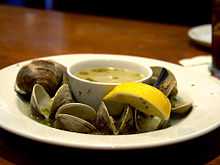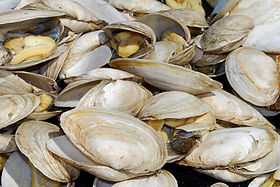Steamed clams

Steamed clams is a seafood dish consisting of various types and preparations of clam which are cooked by steaming according to local custom in various countries.
In the United States the dish is commonly prepared with a kind of shellfish called steamers, a somewhat generic name that usually refers to a small soft-shell clam[1] harvested and served along the East Coast and in New England. Steamers are so named because of the way are most often prepared.[2]
Hard shell clams, sometimes known as quahogs, can also be steamed. They are categorized by size— the smaller ones are called littlenecks, medium-sized ones topnecks, and the larger ones cherrystones.[3][4][5]
The clams used for steaming are usually cooked live. If in a hard shell, the clam should be closed when purchased and should open after being cooked.[6] Soft shell clams are open slightly (agape) while alive.[7] Larger chowder clams are not typically used for steaming.[8]
Preparation

Clams are steamed according to many different recipes in different regions. In China, steamed clams can be served with eggs.[9] In Thailand steamed clams are served with lemongrass, ginger,[10] or herbs.[11] In France they are often cooked with white wine, onion, garlic, shallots, and butter. A huge plate of steamed clams in Restaurant el Club in San Felipe, Mexico, costs 45 pesos, according to a 2007 travel guide.[12] Steamed clams are also eaten in Japan ("Oosari" are large steamed clams), and many other countries with large coastlines.
The New England clam bake is a traditional preparation that includes clams layered with other ingredients such as corn, lobster, mussels, crabs, potatoes, and onions in a metal bucket. The layers are separated by seaweed and steamed over a fire outdoors and served family style as at a picnic.
To prepare steamed clams, live clams are rinsed carefully to remove sand and grit and then cooked in a large kettle of water with salt added. They are served with broth and melted butter for dipping.[4][5] Lemon juice, beer, garlic, shallots, parsley, and wine are sometimes used for flavoring and to season the broth.[4]
Steamers can be held by the siphon or "neck" when eaten. The covering of black skin is pulled away and removed as the clams are ingested.[13]
Steamers may be served simply.[14] In the open shell the clam is given a few quick dips in broth to remove any lingering sand before being dipped in melted butter and eaten.
Notable accounts of steamed clams
In Florida, a couple were halfway through a $10 plate of steamed clams when they found a rare, iridescent purple pearl estimated to be worth thousands of dollars.[15]
Steamers
Steamers are praised by many chefs, for instance Jacques Pépin: "Plentiful and inexpensive during the summer, especially in the Northeast, steamers are one of the great treats of the season."[13] They are found in shallow waters from the Arctic Ocean to North Carolina, and have been found in Florida and Europe.[16] They can be dug up by amateur clam diggers.[17] Steamers have been transplanted to the West Coast and are available from San Francisco to Vancouver, Canada. They are sold in tanks and can also be shipped directly to consumers, but their shells sometimes get cracked.[2]
See also
- Food portal
References
- ↑ Good Housekeeping Magazine, ed. (2001). The Good Housekeeping Illustrated Cookbook: America's Bestselling Step-by-Step Cookbook, with More Than 1,400 Recipes. Hearst Books. p. 162. ISBN 978-1-58816-070-6. Retrieved April 23, 2009.
- ↑ 2.0 2.1 White, Jasper (2000). 50 Chowders: One-pot Meals : Clam, Corn & Beyond. Simon and Schuster. p. 114. ISBN 978-0-684-85034-4. Retrieved April 23, 2009.
- ↑ Johnson, Paul; Petzke, Karl (2007). Fish Forever: The Definitive Guide to Understanding, Selecting, and Preparing Healthy, Delicious, and Environmentally Sustainable Seafood. John Wiley and Sons. p. 87-. ISBN 978-0-7645-8779-5. Retrieved April 23, 2009.
- ↑ 4.0 4.1 4.2 Grad, Laurie Burrows (1991). Make It Easy, Make It Light. Simon and Schuster. pp. 76–77. ISBN 978-0-671-73308-7. Retrieved April 23, 2009.
- ↑ 5.0 5.1 Barchers, Suzanne I.; Marden, Patricia C. (1999). Cooking up U.S. history: recipes and research to share with children. Libraries Unlimited. p. page 86. ISBN 978-1-56308-682-3. Retrieved April 23, 2009.
- ↑ Beard, James; Callvert, Isabel E. (2001). The James Beard Cookbook. Marlowe & Company. pp. 115–119. ISBN 978-1-56924-534-7. Retrieved April 23, 2009.
- ↑ Peterson, James (2007). Cooking. Ten Speed Press. p. 110. ISBN 978-1-58008-789-6. Retrieved April 23, 2009.
- ↑ Berolzheimer, Ruth, ed. (1988). Culinary Arts Institute Encyclopedic Cookbook. Perigee. p. 328. ISBN 978-0-399-51388-6. Retrieved April 23, 2009.
- ↑ Mones, Nicole (2007-08-05). "Food: The Way We Eat - Double Happiness". New York Times. Retrieved 2009-05-27.
- ↑ Sananikone, Keo (1999). Keo's Thai cuisine. Ten Speed Press. p. 58. ISBN 978-1-58008-081-1.
- ↑ Boetz, Martin; Sam Christie; David Thompson; Jeremy Simons (2007). Modern Thai Food: 100 Simple and Delicious Recipes from Sydney's Famous Longrain Restaurant. Tuttle. p. 30. ISBN 978-0-7946-0487-5.
- ↑ Northrop, Laura Cave; Dwight L. Curtis; Natalie Sherman; Raul Carrillo (2007). Let's Go Mexico: On a Budget. Macmillan. p. 174. ISBN 978-0-312-37452-5.
- ↑ 13.0 13.1 Pepin, Jacques (August 25, 1993). "The Purposeful Cook; The Clams That Deserve to Be Steamed". New York Times. Retrieved April 23, 2009.
- ↑ Novick, Susan M. (July 8, 2007). "Hands-On Clams". The New York Times. Retrieved April 23, 2009.
- ↑ "Couple Finds Rare Pearl in Plate of Steamed Clams". FoxNews. January 1, 2008. Retrieved April 23, 2009.
- ↑ Livingston, A. D. (1999). Shellfish Cookbook. Stackpole Books. p. 123. ISBN 978-0-8117-2923-9. Retrieved April 23, 2009.
- ↑ Bryant, Nelson (1990). Outdoors: a personal selection from 20 years of columns from the New York Times. Simon and Schuster. p. 167. ISBN 978-0-671-69372-5. Retrieved April 23, 2009.
| ||||||||||||||||||||||||||||||||||||||||||||||||||||||||||||||||||||||||||||||||||